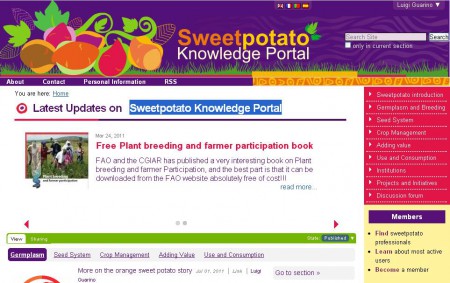- The USDA’s Pullman genebank gets a nice write-up.
- Live from The Missouri Botanical Garden and The Global Partnership for Plant Conservation conference. Crop wild relatives mentioned…
- Hints of a role for growth regulators in germination of recalcitrant seeds.
An online home for sweet potato information
There’s a new online Sweetpotato Knowledge Portal. Lots of stuff on germaplasm conservation, breeding, seed systems, value addition etc. It really does look quite interesting, but, frustratingly, I have no idea who’s behind it. Institutionally, that is. There’s not a logo in sight anywhere. Seems to be driven by sweetpotato researchers themselves, many, but by no means all, at CIP. I shall be watching it closely, via its RSS feed.

Variation in seed dormancy within populations
I asked Robin Probert at the Millennium Seed Bank at Kew to comment on the recent paper “Variation in seed dormancy quantitative trait loci in Arabidopsis thaliana originating from one site.” Here’s the abstract:
A Quantitative Trait Locus (QTL) analysis was performed using two novel Recombinant Inbred Line (RIL) populations, derived from the progeny between two Arabidopsis thaliana genotypes collected at the same site in Kyoto (Japan) crossed with the reference laboratory strain Landsberg erecta (Ler). We used these two RIL populations to determine the genetic basis of seed dormancy and flowering time, which are assumed to be the main traits controlling life history variation in Arabidopsis. The analysis revealed quantitative variation for seed dormancy that is associated with allelic variation at the seed dormancy QTL DOG1 (for Delay Of Germination 1) in one population and at DOG6 in both. These DOG QTL have been previously identified using mapping populations derived from accessions collected at different sites around the world. Genetic variation within a population may enhance its ability to respond accurately to variation within and between seasons. In contrast, variation for flowering time, which also segregated within each mapping population, is mainly governed by the same QTL.
And here’s what Robin had to say:
Sufficient genetic variation for seed dormancy in single populations, especially annuals, is not surprising and we found this many years ago when we were working on Ranunculus sceleratus. 1 In those days we didn’t have the molecular tools now available but is was very clear that individual genotypes selected from single populations had the ability to behave as winter or summer annuals. Nevertheless, there are countless examples in the literature that demonstrate that germination and dormancy are highly adapted to local climate. I guess what the recent papers reveal is that hidden within those striking patterns of adaptation is sufficient genetic variation to cope with climate variation. Whether this will be enough to cope with the scale and rapidity of climate change is another matter. Time will tell.
Indeed it will. While we wait, can anyone explain that “In contrast…” at the end of the abstract?
Nibbles: Orissa genebank, Cornish bees, Andean Roots & Tubers, Ag at WCSJ
- Not content with its seed mothers, or a national or international genebank, the state of Orissa in India wants its own genebank.
- Bee biodiversity.
- Andean root and tuber crops. And none of them a potato!
- Some ag-related reporting from the World Conference of Science Journalists. It isn’t pretty.
Nibbles: Seed mothers, Bees, Strawberry, Chilli collection, Talk on agrobiodiversity
- Need seed? Ask a bihana-maa, at least if you are in Orissa.
- Decline in UK honeybees reveals that crops not so dependent on them after all. Huh?
- A new strawberry for aesthetically-minded home gardeners.
- Wild Chilli group of Europe to visit Experimental Garden and Genebank of the Radboud University of Nijmegen. Send us a report?
- A free talk about the importance of perpetuating food plant resources for the future on Thursday, July 14. Oh, it’s on Hawaii. Send us a report?